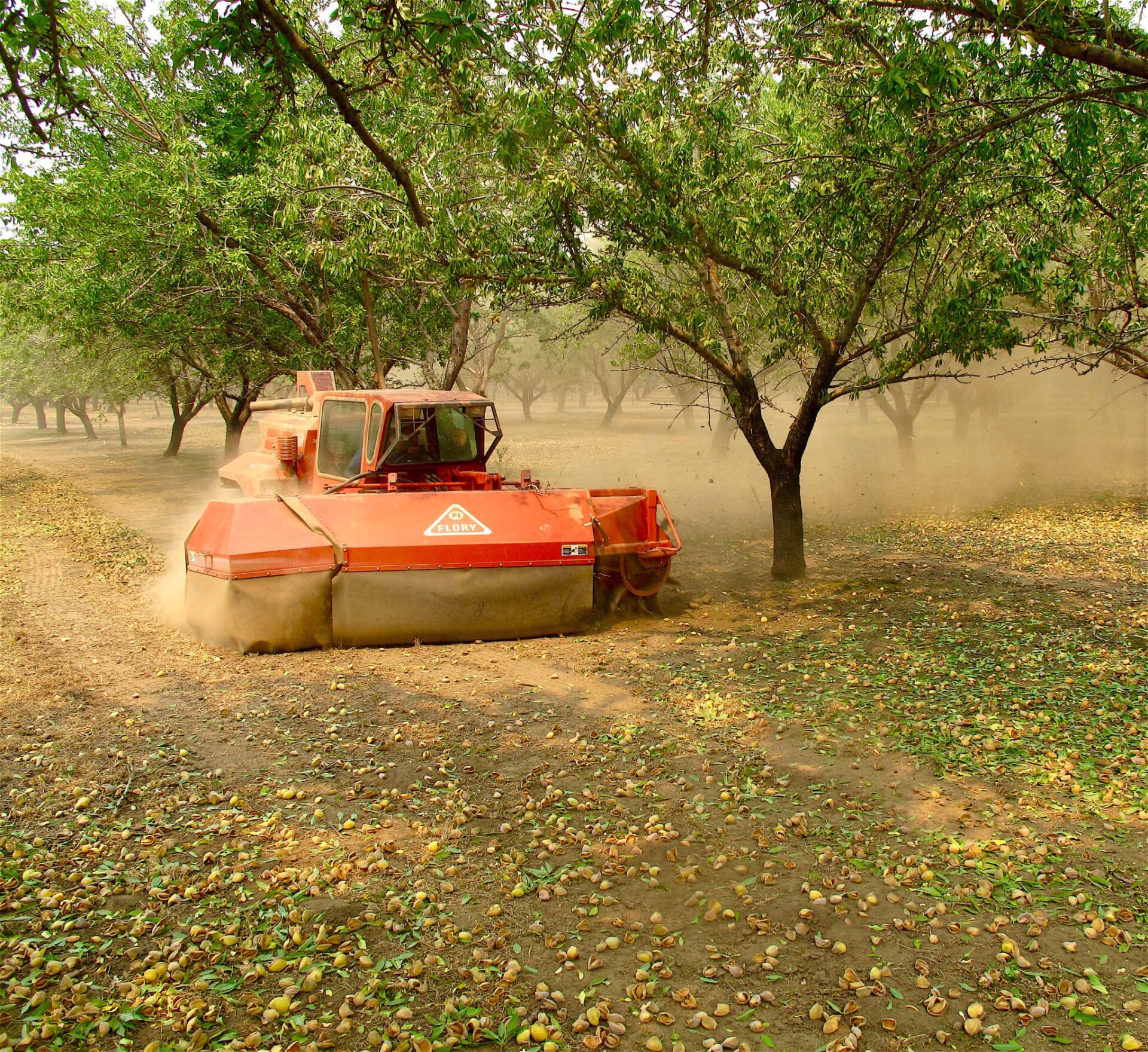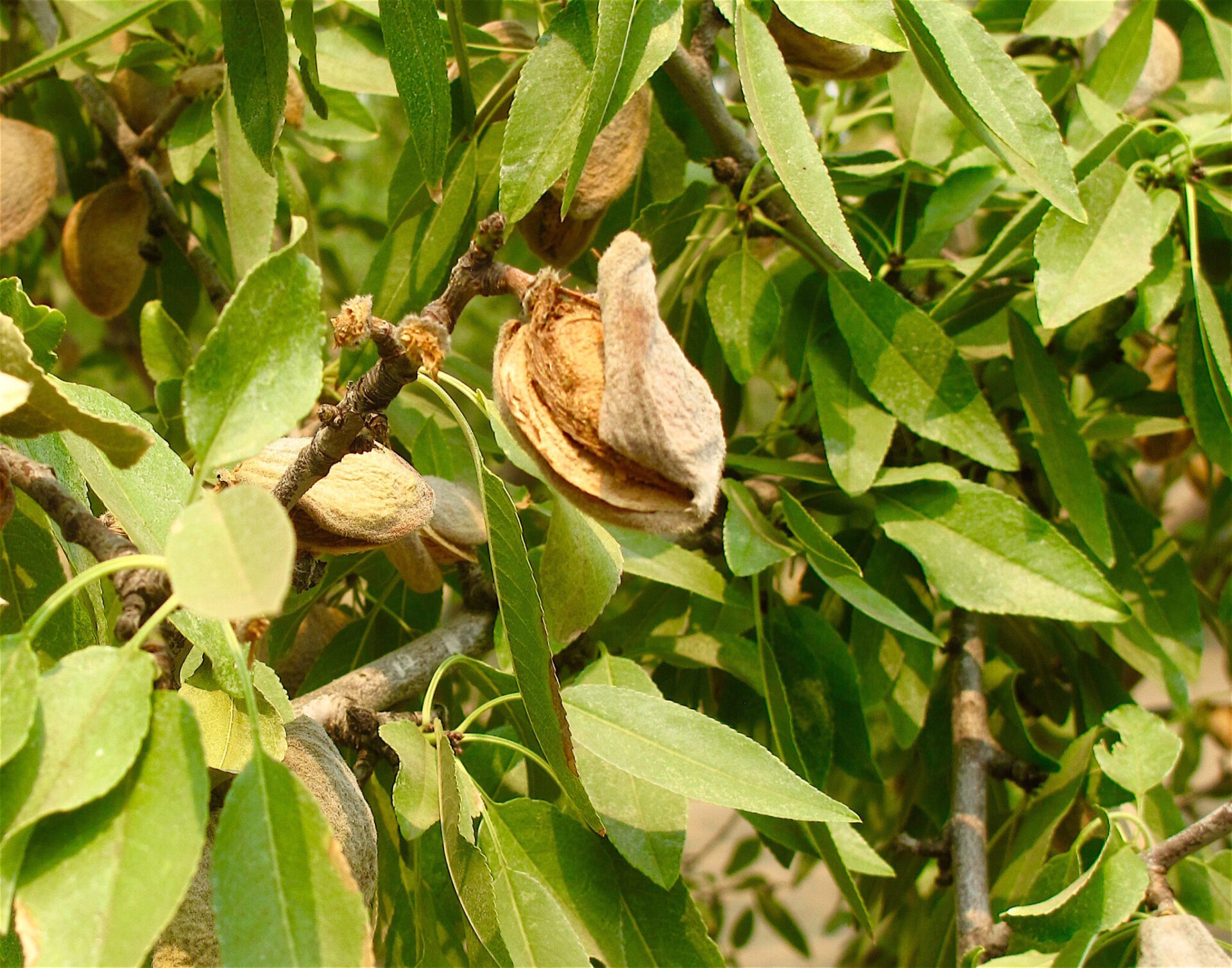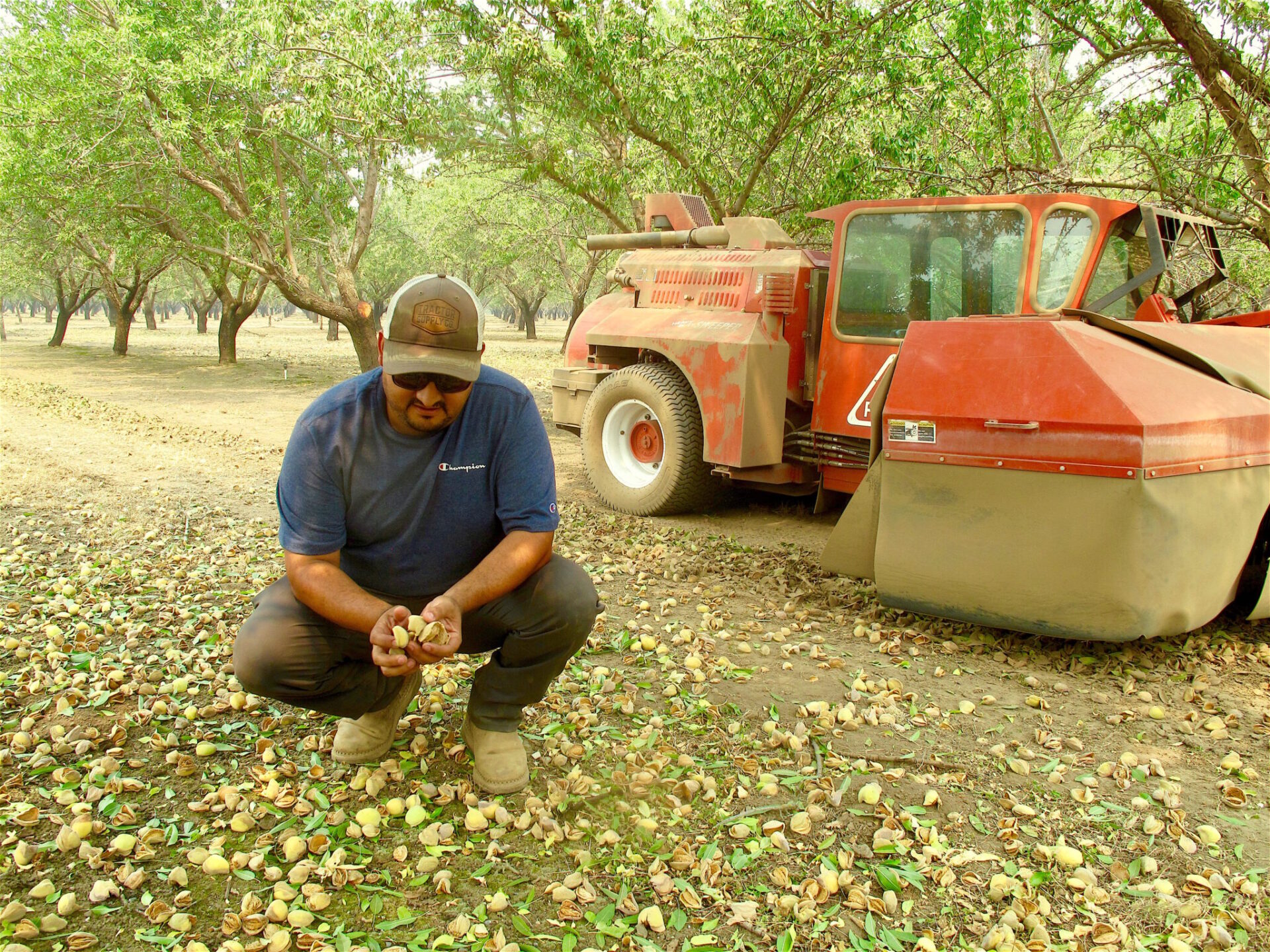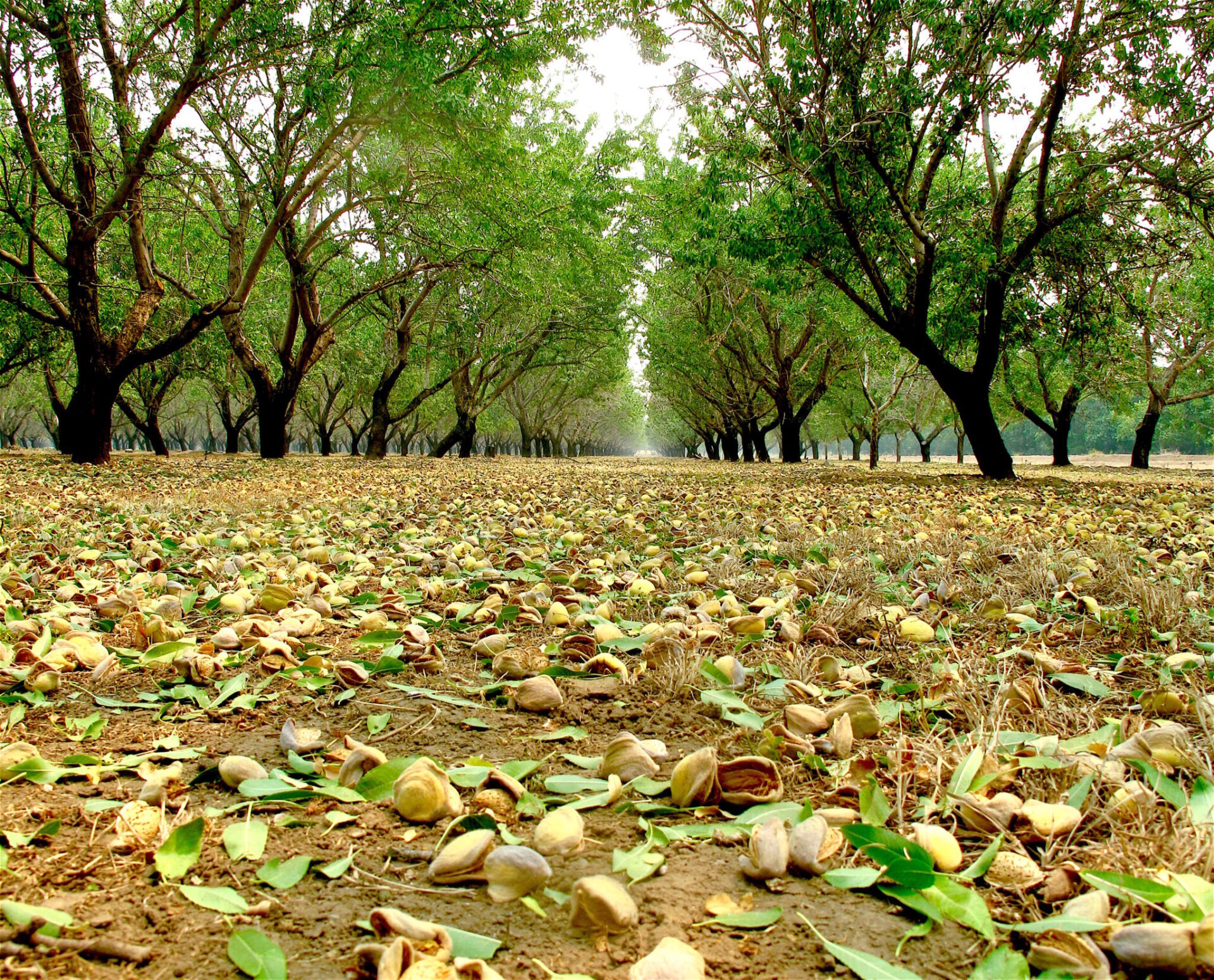
It was August and harvest was underway in most almond orchards across California. For many growers, such as D.C. Felciano, general manager of JJB Farms in Tehama County, this year’s harvest came about two weeks earlier than usual.
“I’m assuming it’s due to the heat and the drought conditions we are suffering through this year,” he said.
Initially, the USDA and NASS had forecast the 2021 almond crop size at 3.2 billion pounds, then in July reduced that estimate to 2.8 billion pounds, a 12.5% reduction, amounting to the largest swing by percentage between the two forecasts since at least the 2002-03 crop year.
“Due to low water allocations and record high temperatures in June, the crop did not develop as well as expected,” the USDA reported.
According to Hugo Cervantes, foreman at JJB Farms, the crop has been well into the average range, but nothing like last year’s record numbers.
“But our quality is good, and I’m assuming because of the drought, we haven’t had as many diseases or pest problems as in the past. We haven’t had to spray for fungus or other issues nearly as much,” he said.
Postharvest Irrigation
As growers were shaking their trees, they were also considering postharvest strategies to keep their orchards as healthy as possible under far-less-than-optimal conditions.
In many orchards across the state, trees are suffering from continued stress due to water shortages and other risk factors as postharvest drought conditions carry on into the fall months.
Luke Milliron, UCCE orchard systems advisor for Butte, Tehama and Glenn counties, said even under drought conditions, growers need to start irrigating as soon as harvest is over.
“If folks have the water, it’s best to make sure the trees aren’t going into dormancy water stressed,” he said.
Cervantes said on the 80 acres of almonds in Vina, Calif., they started irrigating earlier than normal this past spring, and he anticipates they will be irrigating later than usual.
“If we don’t see any rain this fall, we will be irrigating right into dormancy,” he added. “We are on ag wells and have had enough water to keep the trees from going into stress, but the heat has been tough on them.”
Franz Niederholzer, UCCE farm advisor in Colusa, Sutter and Yuba counties, recommends even with limited water resources this year for growers to get as much water into their orchards as possible as water stress from August to October can interfere with next year’s bud development and lead to defoliation, which reduces tree vigor.
“The thing people have to consider at this point is what are your options as far as how much water do you have available to you and what are you going to do with that limited resource,” he said. “You have to consider every scenario, and depending on the circumstances, what are you going to farm next year if there is no water, if there is no rain, where are you going to put the water you do have?”

Act Now for Next Year
Both advisors recommend no matter what a grower’s water conditions are, there are many postharvest practices to perform.
“Nearly all of the standard October, November and December tasks still stand, even amidst a drought,” Milliron said.
“There are things a grower can do this fall that will dictate how things look next year, regardless of whether it rains or not,” Niederholzer added. “Especially under these drought conditions, the standard fall practices are essential. Sanitizing is going to be especially important, and I advise growers to be sure and check their boron levels.”
These are the “standard” practices both Milliron and Niederholzer recommend.
Survey for stick-tights/mummy nuts. Nuts stuck to the tree well after harvest may indicate hull rot. In certain areas, this could also be a result of high boron. If hull rot is indicated, consider revising irrigation and nitrogen management practices that may encourage hull rot next year. If more than two nuts per tree remain, plan to knock off and destroy mummies by February 1 to reduce navel orangeworm and brown rot.
If rust infection was heavy this year, consider a foliar zinc sulfate spray to hasten leaf fall to ensure infected leaves don’t carry over into next season. Wait until late October or early November to allow leaves time to continue making photosynthate and build up energy storage in the trees after harvest.
Watch for shot hole fruiting structures in leaf lesions after fall rains begin. If fruiting structures producing spores are present in leaf lesions in the fall, there is a greater risk of shot hole development the following spring. Foliar zinc sulfate applied in late October or early November can also hasten leaf fall and reduce shot hole inoculum.
Scout for weeds after the first fall rains if there are any. Look for late summer weeds that escaped this year’s control and winter annual weeds that are just emerging. UC IPM has a late fall weed survey form that can help. The UC Weed ID Tool may also help.
Consider a fall nutrient spray. Check hull boron and leaf zinc analysis results to help determine if a foliar spray of either or both nutrients is needed.
Milliron said the discussion of planting a cover crop to improve soil, provide pollen to bees, and/or reduce runoff may be a bit debatable with the scarcity of water this year.

Fall Forward
Moving into November, growers have been advised to apply banded potassium to the soil if it is a needed part of their fall schedule.
However, Milliron explained, banding with potassium chloride is not advised if drought conditions continue as insufficient rain won’t be available to leach the chloride.
In line with UCCE advice, Milliron recommends, if planning early pruning, watch the weather forecast. Especially in young orchards, avoid pruning ahead of forecast rain. Disease spores are spread in rain events, so pruning would increase the risk of infection. Grower experience suggests the worst timing for infection may be November. UC researchers are investigating pruning timing relative to rain and infection risk.
Also, sample dormant spurs for scale, mite eggs and scab sometime between mid-November and mid-January. Collect a total of 100 spurs from 35 to 50 trees randomly selected from each orchard.
In case of a very wet winter, Niederholzer said to check that drains are clear early in the fall instead of when there is water on the ground and it becomes critical to get standing water off the orchard floor.
While the future is unknown, if there will be adequate rain or not this coming winter and next spring, Niederholzer advises growers to make plans that will work in each of the possibilities, rain or shine.
















